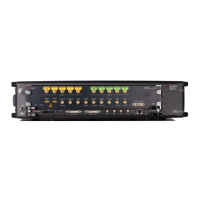This is an example for a two-channel correction file:
ChannelNum, 2
InputBlockSize, 1024
XStart, 1.0E+09
XDelta, 1.0E+06
YUnit, lin
Y
0.987, -0.2343, 0.976, -0.1827
0.995, 0.5674, 0.975, -0.1645
…
…
1.269, -0.765, 1.190, -0.5632
The above files are composed of a header with relevant information. In these particular
cases, the files contain 1024 linear correction factors spaced by 1 MHz and starting at
1GHz. The ‘Y’ character indicates the starting point for the correction factor list
composed of 1024 lines with amplitude/phase pairs separated by commas. For one-
channel files there is a amplitude/phase pair per line while for two channel files there
are two pairs (Amp1, Phase1, Amp2, Phase2).
The way this information is applied by the Soft Front Panel software depends on the
signal generation mode. For direct conversion modes (‘Generate IQ’ unchecked),
corrections are applied directly to the tones based on their absolute frequency. For
up-converted modes (‘Generate IQ’ checked), corrections are applied to the complex
baseband signals. So, the internal or external carrier frequency is represented by the
central entry in the list (i.e., entry #512 in the 1024 entries example shown above)
regardless of the ‘XStart’ parameter.
The M8190 Soft Front Panel can connect to an already running M8190 Firmware, which
was started previously.
If no M8190 Firmware instance was started for the selected hardware yet, the Soft Front
Panel will start it. In this case, the Firmware’s window is minimized and only an icon in
the taskbar’s notification area is shown.
It is recommended to exit the Soft Front Panel before the Firmware; otherwise, the Soft
Front Panel will continue to try to communicate with the Firmware. This will of course
fail and the Soft Front Panel will display error messages.

